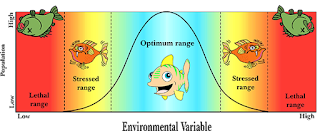Tolerance range
Tolerance Range in biology refers to the specifications of environment in which particular species can survive. These environmental factors include temperature, humidity, salinity, quality of soil and quality of air.
Tolerance range differs from one species to another. Factors included in tolerance range differ too. For plants, crucial environmental conditions include sunlight and minerals in soil, whereas for animals temperature and quality of air are important. For both plants and animal, a certain amount of nutrients must be available to them to consume in order to survive. Range of tolerance also varies within a given population, from individual to individual, and across a life cycle of one individual.
If living organisms find themselves within their range tolerance, they can maintain homeostasis, meaning the internal conditions necessary for carrying out their life functions. The optimum range is the mid-point on the scale of tolerance range, where most individuals in a population feel comfortable. If oxygen supply to a fish tank is severely reduced, most of the individual fish will die, and the rest will experience physiological stress. Acclimation, or gradual getting used to extreme conditions is possible for living beings. However, once the point of threshold effect is passed, the species goes beyond that tolerance range and dies (see graph 1).
Graph 1. The Tolerance Range of Fish
Graph 2. Tolerance Range of organism




Nice information Ais
BalasHapusSemangat untuk terus menulis hehe